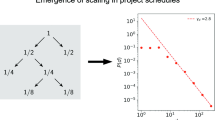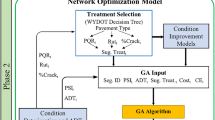Summary
The paper surveys available algorithms for resource allocation in project networks that appear computationally efficient. Three cases of resource allocation are considered: time-cost tradeoff, leveling of resources, and constrained resources. Practical analytical methods that guarantee optimal solutions exist only for the time-cost tradeoff problem. Heuristic procedures for problems with constraints on resources do not guarantee but come close to optimal solutions. Relative advantages of heuristic algorithms cannot be assessed in the absence of large scale empirical comparisons.
Zusammenfassung
Die vorliegende Arbeit gibt einen Überblick über Algorithmen für die Verteilung der Ressourcen in Netzwerk-Projekten, die rechnerisch effizient erscheinen. Es werden 3 Fälle der Verteilung von Ressourcen betrachtet: „time-cost tradeoff“, „leveling of resources“ und „constrained resources“. Praktische analytische Methoden, die optimale Lösungen garantieren, existieren nur für das „time-cost tradeoff“ Problem. Heuristische Verfahren für Probleme mit Beschränkungen garantieren zwar keine optimalen Lösungen, führen aber eng an sie heran. Die relativen Vorteile, die durch heuristische Programme erzielt werden, können beim Fehlen empirischer Vergleichsmöglichkeiten großen Stils nicht abgeschätzt werden.
Similar content being viewed by others
References
Alpert, L. andD. S. Orkand: A Time Resource Trade-off Model for Aiding Management Decisions. Operations Research, Inc., Technical Paper No. 12, Silver Spring, Maryland 1962.
Berman, E. B.: Resource Allocations in a PERT Network under Continuous Time-Cost Functions. Management Science, Vol. 10, No.4 (1964), 734–745.
Burgess, A. R. andJ. B. Killebrew: Variation in Activity Level on a Cyclical Arrow Diagram. Journal of Industrial Engineering, Vol. XIII, No. 2 (1962), 76–83.
de Witte, L.: Manpower Leveling of PERT Networks. Data Processing for Science/Engineering (March-April 1964), 29–38.
Fulkerson, D. R.: A Network Flow Computation for Project Cost Curves. Management Science. Vol. 7 No. 2 (1961), 167–178.
Jewell, W. S.: Risk-Taking in Critical Path Analysis. Management Science, Vol. 11 (1965), 438–443.
Kelley, J. E. andM. R. Walker: Critical Path Planning and Scheduling. 1959 Proceedings of the Eastern Joint Computer Conference 160–173.
Kelley, J. E.: Critical-Path Planning and Scheduling: Mathematical Basis. Operations Research, Vol. 9 (1961), No. 3, 296–320.
——: The Critical Path Method: Resources Planning and Scheduling. Chapter 21 in: Muth and Thompson (eds.), Industrial Scheduling, Prentice-Hall, Englewood Cliffs, 1963.
Lambourn, S.: RAMPS — A New Tool in Planning and Control. Computer Journal, Vol. 5, No. 4 (1963), 300–304.
Levy, F. K., G. L. Thompson andJ. D. Wiest: Multiship, Multishop, Workload-Smoothing Program. Naval Research Logistics Quarterly, Vol. 9, No. 1 (1962), 37–44.
McGee, A. A. andM. D. Markarian: Optimum Allocation of Research/Engineering Manpower within a Multi-Project Organizational Structure. IRE Transactions on Engineering Management (September 1962) 104–108.
Meyer, W. L. andL. R. Shaffer: Extensions of the Critical Path Method through the Application of Integer Programming. Department of Civil Engineering, University of Illinois, July 1963.
Moder, J. J. andC. R. Phillips: Project Management with CPM and PERT. Reinhold, New York, 1964.
Moshman, J., J. Johnson andM. Larsen: RAMPS — A Technique for Resource Allocation and Multi-Project Scheduling. AFIPS Conference Proceedings, Vol. 23 (1963), 17–27.
Parikh, S. C. andW. S. Jewell: Decomposition of Project Networks. Management Science, Vol. 11 No. 3 (1965), 444–459.
Phillips, C. R.: Fifteen Key Features of Computer Programs for CPM and PERT. Journal of Industrial Engineering, Vol. XV, No. 1 (1964), 14–20.
Prager, W.: A Structural Method of Computing Project Cost Polygons. Management Science, Vol. 9, No. 3 (1963), 394–404.
Verhines, D. R.: Optimum Scheduling of Limited Resources. Chemical Engineering Progress, Vol. 59, No. 3 (1963), 65–67.
DOD and NASA Guide, PERT/Cost: Office of the Secretary of Defense, and National Aeronautics and Space Administration. Washington, D. C., June 1962.
PERT, Phase I Summary Report: Special Projects Office, Bureau of Ordnance, Department of the Navy. Washington, D. C., July 1958.
Author information
Authors and Affiliations
Additional information
Vorgel. v.:G. Tintner.
Rights and permissions
About this article
Cite this article
Laue, H.J. Efficient methods for the allocation of resources in project networks. Unternehmensforschung Operations Research 12, 133–143 (1968). https://doi.org/10.1007/BF01918321
Received:
Issue Date:
DOI: https://doi.org/10.1007/BF01918321




